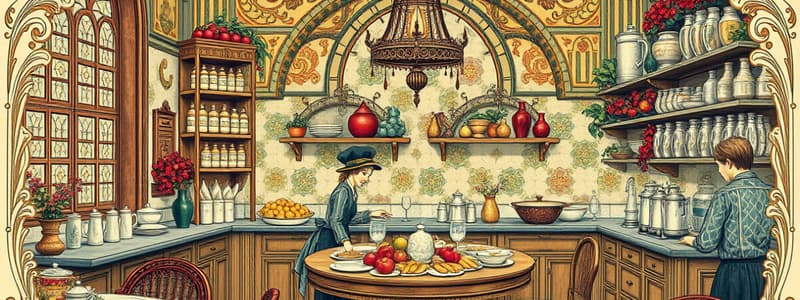Podcast
Questions and Answers
What were early humans primarily engaged in for sustenance during the Stone Age?
What were early humans primarily engaged in for sustenance during the Stone Age?
Hunting and gathering
What significant agricultural development occurred around 10,000 BC?
What significant agricultural development occurred around 10,000 BC?
The Agricultural Revolution
The region where the Agricultural Revolution first took place is known as the ______.
The region where the Agricultural Revolution first took place is known as the ______.
Fertile Crescent
What was significant about the first leavened bread?
What was significant about the first leavened bread?
What was the general state of society during the Medieval Period?
What was the general state of society during the Medieval Period?
What were the staple foods in the Medieval Period for the upper-class and lower class?
What were the staple foods in the Medieval Period for the upper-class and lower class?
Who were Master Cooks referred to during the Medieval Period?
Who were Master Cooks referred to during the Medieval Period?
What significant contributions did Italian cuisine make during the Renaissance?
What significant contributions did Italian cuisine make during the Renaissance?
Which Italian noblewoman brought Italian cooking to the French court?
Which Italian noblewoman brought Italian cooking to the French court?
What dish was first introduced in Sicily influenced by Chinese noodle-making?
What dish was first introduced in Sicily influenced by Chinese noodle-making?
Flashcards are hidden until you start studying
Study Notes
Learning Outcomes
- Understand the evolution of the culinary industry over time.
- Recognize influential figures in the culinary field.
- Familiarize with classical and French culinary terminologies.
History of Modern Food Service: Culinary Timeline
-
Hunting, Gathering, and Stone Age Cooking (Approximately 12,000 years ago)
- Early humans were nomadic hunter-gatherers, focusing on sustenance.
- Diet included small animals, insects, fruits, nuts, and berries.
- Discovery of fire led to initial cooking methods such as roasting and pit-roasting.
-
Agricultural Revolution (Circa 10,000 BC)
- Shift from nomadic to farming lifestyles for sustainability.
- First domestication of plants and animals occurred in the Fertile Crescent (Iraq, Syria, eastern Turkey, Lebanon, Israel).
- Cultivation of barley and wheat; first leavened bread emerged in Egypt.
- Wine production began, and agricultural innovations by the Incas, Mayans, and Aztecs included a three-crop system (maize, beans, squash) and irrigation techniques.
-
Medieval Period/Middle Ages (1400-1450s)
- Characterized by violence and class disparity; food intake varied significantly by social status.
- Bread became a staple; white bread was for the wealthy, while dark bread served the poor.
- Pigs and young goats/lambs were primary sources of fresh meat for consumption.
- Use of spices for flavoring and medicinal purposes was widespread.
- Master cooks were referred to as Squires, indicating prestige in culinary roles.
-
The Renaissance (14th – 17th Century)
- Italian cuisine flourished, emphasizing elite and quality food.
- This era established benchmarks in food culture, including table manners and cooking styles.
- Persistent disparity existed between wealthy and poor classes, with simple fare known as cucina povera (peasant food).
- Introduction of pasta in Sicily, inspired by Chinese noodle-making techniques.
- Catherine de Medici, an Italian noblewoman, brought chefs and Italian culinary traditions to France, influencing royal court cuisine.
Studying That Suits You
Use AI to generate personalized quizzes and flashcards to suit your learning preferences.




